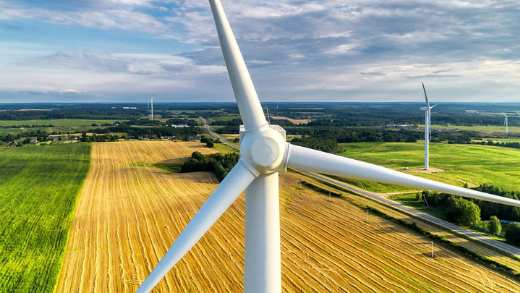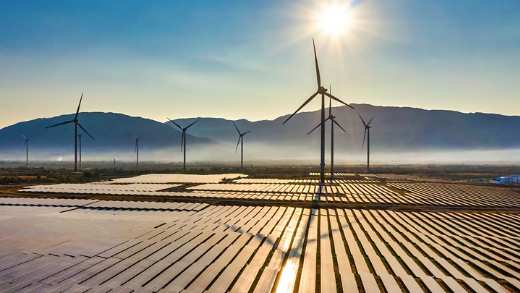Warnings that natural systems are close to breaking point are not new – but how will we respond? Combining what we know with existing technologies could be a remarkable opportunity to rethink our world, as Nafeez Ahmed explains.
Read this article to understand:
- The natural boundaries defining our relationship with the planet
- Why changing what we do in five key areas – energy, transport, food, information and materials – could radically improve the global outlook
- How new developments do not necessarily offer one-for-one substitutions, but give scope to upend systems entirely
Back in the 1970s, US academic Dennis Meadows was working at the Massachusetts Institute of Technology, undertaking systems modelling. His work ultimately prompted him to step forward with a bold thought:
“If present growth trends in world population, industrialisation, pollution, food production and resource depletion continue unchanged, the limits to growth on this planet will be reached sometime within the next 100 years,” he wrote.1
Fifty years on, the natural world faces a variety of major stresses, but we also have more tools at our disposal – in information technology, energy generation and precision biology – which can be put to work.
Dr Nafeez Ahmed, director of global research communications at thinktank RethinkX, is a respected voice on the risks and opportunities of system transformation. He spoke to AIQ to give his take on where we are and what needs to happen next to put the global economy on a more sustainable footing.
You have spoken about feedback loops and how collapse in one system – food or water or geopolitics – could lead to collapse in another. Can you elaborate?
It is difficult to pin a single issue down. The danger is there are a lot of different things happening at the same time. That overwhelms our institutional capacity to respond, and we are starting to see this play out.
We have the climate challenge, and it is escalating
We have the climate challenge, and it is escalating. There are always natural disasters taking place, but there is something about the intensity and simultaneous nature of events recently. These trends were coming into play even before the war in Europe, but are now intensifying. This is what happens when you fail to think systemically or holistically: you bunker down in the traditional way of thinking.
Where is the biggest potential for a negative feedback loop?
The key detail is the connection between Earth-system disruption and human-system destabilisation. When you have things happening in the Earth system that accelerate shocks, we must respond. The fire engines must come out and put fires out, and that will create costs. Politicians need to think about that; but the reality is that certain industries are risk-taking, and we are doing destructive things.
There is a danger we get lost in that symptom-oriented approach. If we focus too much on dealing with the symptoms, we forget the whole system, the big picture, and then we are more vulnerable to the next crisis.
What are the key areas with the potential for positive transformation?
If we look at the five foundational sectors in the economy – energy, transport, food, information and materials – existing technologies are going through a familiar pattern of exponential cost reductions and improvements in effectiveness which have historically driven exponential adoption. In these sectors, genuinely disruptive technologies have the potential to solve many of our biggest challenges.
Technologies already exist and are scaling at an exponential rate that has taken many incumbents by surprise
Energy, transport and food are key, accounting for 90 per cent of carbon emissions. In energy, we are looking at solar, wind and batteries (SWB); in transport, electric vehicles (EVs), the potential for autonomous vehicles, and a new model called transport-as-a-service. We are looking at precision fermentation in the food system, and that is driving a revolution in plant-based proteins. This is linked with cellular agriculture, extending the revolution into animal proteins without having to kill animals.
These technologies already exist and are scaling at an exponential rate that has taken many incumbents by surprise. Conventional analysts have consistently failed to anticipate how rapidly the change might happen, and how the performance of these technologies is getting better all the time.
These new technologies are not going to be like-for-like substitutions, either. For example, a car wasn't a faster horse; it was wholly different. It completely changed the game. Many of these technologies are similar in the sense they will not be slightly better than what has gone before: they will completely change the way we do things.
What are the prospects of multilateral agreement to ensure change happens?
Many of the largest and most powerful actors in the world do not understand the environment we are in now. If we use the framing of the adaptive cycle identified across nature by the late systems ecologist Crawford Holling, global civilisation has experienced a growth stage, a conservation stage and is moving into the release and reorganisation stages. It is a period of breakdown and uncertainty but also radical opportunities for new things.
We are capable of recognising the inflection point we are arriving at
Civilised societies have been here before, but the difference is that they did not know it. That is different now, because of the knowledge we have and the kind of conversations underway. We are capable of recognising the inflection point we are arriving at.
But we are still not quite there: until we have people and organisations able to see this moment for what it is – a fundamental phase transformation – to inform our choices, it could go either way.
How can we open conversations through a more holistic systems lens?
We need to be mindful in the meantime that the conversation has become quite reductionist. It involves asking: “Which evil guys created this mess?” What’s been done has terrible consequences for the environment, and it is difficult to tackle.
There is another narrative we could follow. We simply need to ask: “Does what we are doing make sense? Is it rational to work and invest like this? Are these assets stranded, and will the investments around them therefore collapse within the next ten years?” Incumbent industries need to know that if powerful groups and governments are funding them, it is in everyone's interest to understand whether their assets are at risk of stranding.
When we understand the predictable pattern of technology disruptions throughout history, we realise certain industries are bound to become obsolete due to economic factors well within the next two decades. That process is unstoppable. But if this is allowed to happen without protecting people, it will be devastating for everyone.
You mentioned a lack of societal self-knowledge. Where are the blind spots?
One of the biggest relates to a lack of understanding about the technology solutions impacting the key foundational sectors of our economy. Recognition of disruptions in energy, transport and food is not widespread.
Understanding the specific dynamics of how those technologies are impacting cost curves, and the relationships between those curves and adoption rates, is not widely understood.
We need to understand disruption as a lever for system change. Disruptions are never just one-for-one substitutions
We also need to understand disruption as a lever for system change. Disruptions are never just one-for-one substitutions. They always create new systems with new rules, properties and dynamics. Only by recognising and reorganising our societies to adapt to these new system dynamics can we be in a position to harness, maximise and distribute the benefits.
With EVs, for instance, lots of people are asking about materials scarcity. One of the insights we had is that EVs will not only become cheaper, but autonomy will drop costs further. Ride hailing, using transport-as-a-service, will be cheaper than owning and managing your own car.
It might happen through a private market system. It might be something governments choose to build as a public transport system. Either way, driven to mass adoption by the cost trajectory, transport-as-a-service will mean you need a fraction of the vehicles on the road today. Coupled with no longer needing seasonal battery storage due to supersizing generating capacity, this will change the story on materials requirements completely.
What about the financial system?
One major misunderstanding of the energy, transport and food transformations is the assumption they need to be state-driven. While the state has an important role to play, markets can do the bulk of the work. That is because the key technology disruptions are scaling for economic reasons. As their costs of production are plummeting exponentially, the opportunities for returns are growing exponentially.
We need free and fair electricity markets, and we need the same in food and transport
Subsidies for these technologies are not needed – only strategic support for specific difficult areas such as residential heating. The key challenge is to remove market barriers, such as subsidies for incumbents. We need free and fair electricity markets, and we need the same in food and transport. An ‘Energy Bill of Rights’ underpinning the rights of individuals to own and trade electricity would unleash entrepreneurial drive.
Finance wants to move in but is constrained when markets are skewed toward incumbent interests that often distort perceptions of risk and opportunity. We need to ensure investors and others think through the issues coherently.



















